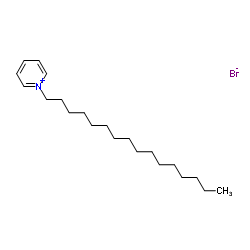Cetylpyridinium Bromide

Cetylpyridinium Bromide structure
|
Common Name | Cetylpyridinium Bromide | ||
|---|---|---|---|---|
| CAS Number | 140-72-7 | Molecular Weight | 384.437 | |
| Density | N/A | Boiling Point | N/A | |
| Molecular Formula | C21H38BrN | Melting Point | 63-69 °C | |
| MSDS | Chinese USA | Flash Point | N/A | |
| Symbol |

GHS06 |
Signal Word | Danger | |
|
The EpiOcular Eye Irritation Test (EIT) for hazard identification and labelling of eye irritating chemicals: protocol optimisation for solid materials and the results after extended shipment.
Altern. Lab. Anim. 43 , 101-27, (2015) The 7th Amendment to the EU Cosmetics Directive and the EU REACH Regulation have reinforced the need for in vitro ocular test methods. Validated in vitro ocular toxicity tests that can predict the human response to chemicals, cosmetics and other consumer prod... |
|
|
Multi-target spectral moment QSAR versus ANN for antiparasitic drugs against different parasite species.
Bioorg. Med. Chem. 18 , 2225-31, (2010) There are many of pathogen parasite species with different susceptibility profile to antiparasitic drugs. Unfortunately, almost QSAR models predict the biological activity of drugs against only one parasite species. Consequently, predicting the probability wi... |
|
|
Controlling the Microstructure of Reverse Micelles and Their Templating Effect on Shaping Nanostructures.
J. Phys. Chem. B 119 , 11295-306, (2015) Reverse micelles as nanoreactors have been most successful in designing nanostructures of different sizes and shapes. Nevertheless, important questions regarding the explicit roles of intrinsic parameters in modifying soft colloid templates which eventually g... |
|
|
Synthesis and antibacterial activity study of a novel class of cationic anthraquinone analogs.
Bioorg. Med. Chem. 19 , 498-503, (2011) Reported previously by our group, one-pot cycloaddition using naphthoquinone, sodium azide and alkyl halides can lead to the formation of both 1-alkyl-1H- and 2-alkyl-2H-naphtho[2,3-d]triazole-4,9-diones. Herein, the effect of leaving group and additive in di... |
|
|
Synthesis and antibacterial properties of novel hydrolyzable cationic amphiphiles. Incorporation of multiple head groups leads to impressive antibacterial activity.
J. Med. Chem. 48 , 3823-31, (2005) Two sets of novel multiheaded cationic amphiphiles bearing one, two, and three trimethylammonium headgroups (T1, T2, and T3) and pyridinium headgroups (P1, P2, and P3), have been synthesized and tested for antimicrobial activities against both Gram-positive a... |